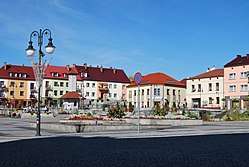Trzebinia
Trzebinia ([tʂɛˈbʲiɲa]; Yiddish: טשעבין Tchebin) is a town in Chrzanów County, Lesser Poland, Poland with an Orlen oil refinery and a major rail junction of the Kraków - Katowice line, with connections to Oświęcim and Spytkowice. The town became part of Lesser Poland Voivodeship after being part of Katowice Voivodeship (1975–1998). With population of 20,175 (Dec. 31, 2010), Trzebinia is an important industrial center. The town lies in the Kraków-Częstochowa Upland, 269 to 407 m (883 to 1,335 ft) above sea level. Trzebinia is a rail and road hub, and lies at a junction of the A4 Motorway and National Road Nr. 79. The distance to John Paul II International Airport Kraków-Balice is 30 kilometres (19 miles).
Trzebinia | |
|---|---|
 Market square in 2012 | |
 Flag  Coat of arms | |
 Trzebinia | |
| Coordinates: 50°10′N 19°29′E | |
| Country | |
| Voivodeship | Lesser Poland |
| County | Chrzanów |
| Gmina | Trzebinia |
| Government | |
| • Mayor | Jaroslaw Okoczuk |
| Area | |
| • Total | 31.3 km2 (12.1 sq mi) |
| Population (2006) | |
| • Total | 18,769 |
| • Density | 600/km2 (1,600/sq mi) |
| Time zone | UTC+1 (CET) |
| • Summer (DST) | UTC+2 (CEST) |
| Postal code | 32-540 |
| Car plates | KCH |
| Website | Town guidebook |
History
History of Trzebinia dates back to the late Middle Ages. In 1325, the settlement already had a church, which was mentioned in 1470 by Jan Długosz. Until the early 15th century, Trzebinia was a royal village, then it passed into the hands of local noble families. At that time, zinc and lead deposits were discovered here. Trzebinia, however, still remained a village, or rather a mining settlement, which from 1569 until 1802 belonged to the Schilhra Trzebiński family, Abdank coat of arms. Until the Partitions of Poland Trzebinia belonged to Kraków Voivodeship. In 1772 it was annexed by the Austrian Empire, as part of Galicia, where it remained until late autumn of 1918 (also, in 1815 - 1846, Trzebinia was part of the Free City of Kraków). In the 19th century the area of Trzebinia went through the period of industrialization. In 1804-1843, five coal mines, two zinc mills and a glass factory were opened here. On September 6, 1817, the village received its town charter, and in the second half of the 19th century, further coal mines were opened here, as well as a calamine mine. In the early 20th century, Trzebinia had oil refinery, power plant, and cement mill. In 1903, the Salvatorians settled here, who in 1908 began construction of a church.
On September 1, 1939, Trzebinia was bombed by the Luftwaffe. On October 9, 1939, it was directly annexed into the Third Reich; the border with the General Government was a few kilometers east, near Dulowa. On 5 September 1939 during the German Invasion of Poland, Wehrmacht soldiers mass murdered 97 people in the town.[1] In August 1944, the German Trzebinia subcamp was one of the largest of the Auschwitz III-Monowitz concentration camp and provided forced labor for a nearby oil refinery.[2] On September 7, 1944, the refinery at Trzebinia was bombed by Allied airforce, and on January 23, 1945, the Germans retreated.
During the Second World War the village known as Arthurgrube, later renamed Siersza Wodna (and now incorporated into Trzebinia) was the base for a working party (E565) of British and other Commonwealth prisoners of war, under the administration of Stalag VIIIB/344 at Łambinowice (then known as Lamsdorf) in Poland. Their work was in a coal mine, and their living accommodation was in wooden huts by the river. More Lamsdorf prisoners of war transferred in January 1944 from Ottmachau in Upper Silesia to an Auschwitz detachment at the Trzebinia oil refinery. All 45 members of the detachment were from Commonwealth countries. A document at the State Museum of Auschwitz-Birkenau confirming arrival of POW Work Detachment E738 at Trzebinia is dated 25 February 1944. In January 1945, as the Soviet armies resumed their offensive and advanced from the east, the prisoners were marched westward in the so-called Long March or Death March. Many of them died from the bitter cold and exhaustion. The lucky ones got far enough to the west to be liberated by the allied armies after some four months of travelling on foot in appalling conditions.[3]
Until 1975, the town remained in Kraków Voivodeship. In 1961, the settlement of Wodna was incorporated into Trzebinia, and in 1969, after joining with the settlement of Siersza, the town was named Trzebinia-Siersza. In 1977, the name was changed to Trzebinia. The name Siersza Wodna survives as the name of a freight railway station.
Economy
Trzebina is home to the Siersza Power Station, a large oil refinery, Rafineria Trzebinia, which belongs to PKN Orlen and cement plant Gorka Cement (a part of Mapei). In 1957-1958 Mining Company Trzebionka was founded, and in 1962, Siersza II Power Plant began operating. Liquidated: zinc and lead mine - ZG Trzebionka, coal mine - KWK Siersza, metallurgical plants - ZM Trzebinia.
Sports
The town is home to sports club Miejski Klub Sportowy Trzebinia–Siersza, founded in 2000.
Notable people from Trzebinia
- Antonina Hoffmann, actress
- Dov Berish Weidenfeld, rabbi
Notes
- Datner, Szymon. 55 Dni Wehrmachtu w Polsce (in Polish). p. 239.
- "The sub-camp Trzebinia (oil refinery). Des Nebenlagers Trzebinia (Erdöl-Raffinerie)" (Google translate). Chronology: August 1944. Der Auschwitz - Prozess. Retrieved August 27, 2012.
- http://www.lamsdorf.com
External links
![]()
- 19km From Auschwitz: The Story of Trzebinia an online exhibition by Yad Vashem
- Jewish Community in Trzebinia on Virtual Shtetl